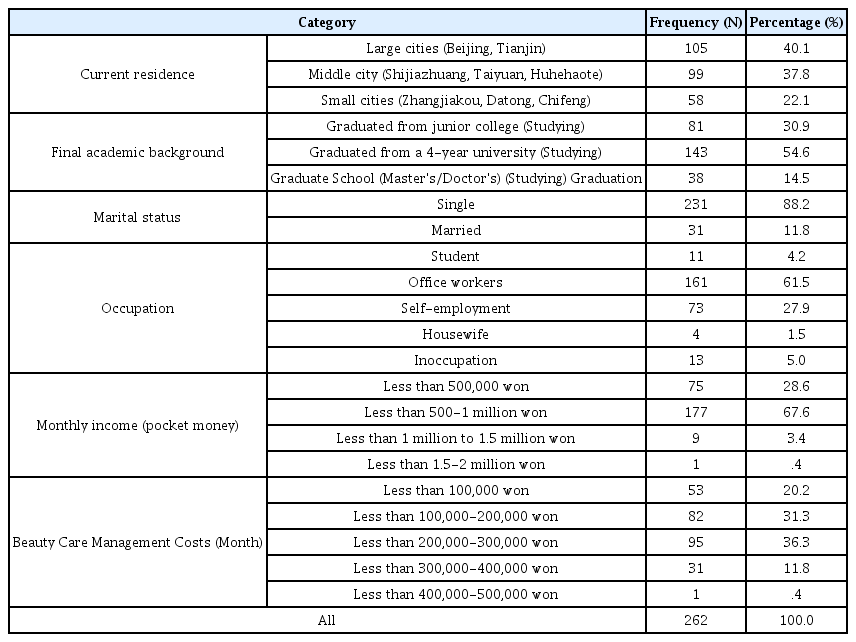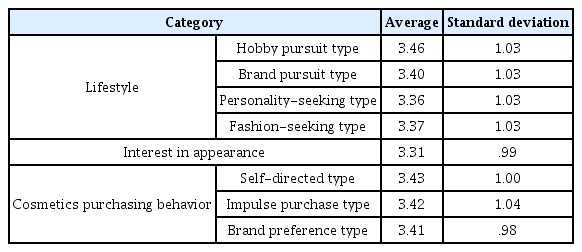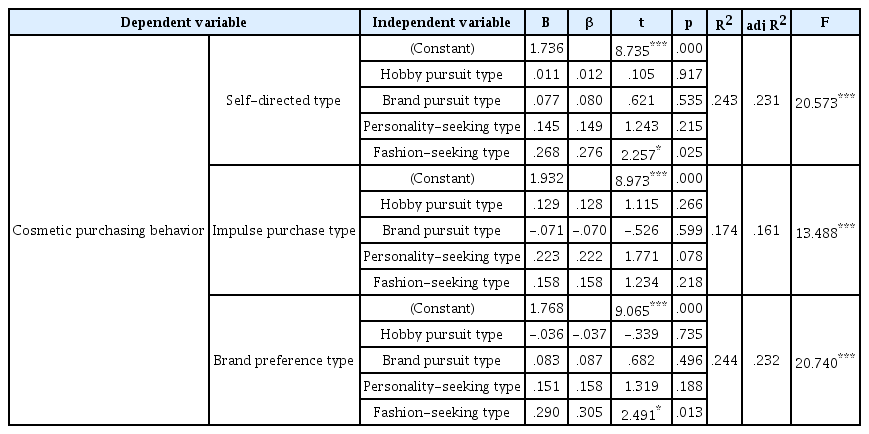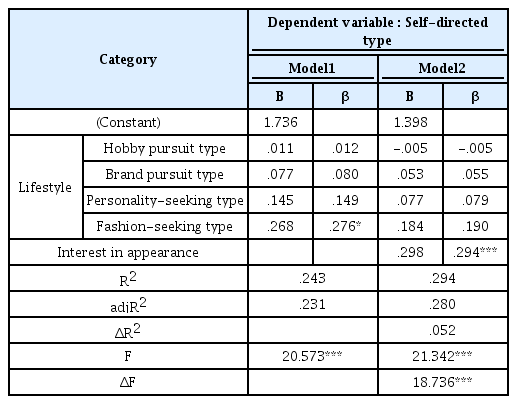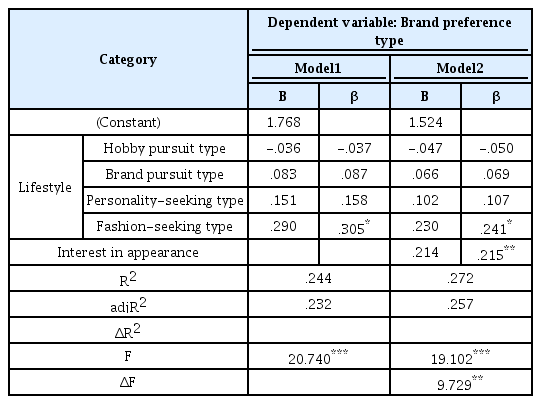중국 20대 여성의 라이프스타일과 화장품구매행동과의 관계에서 외모관심도의 매개효과
The Mediating Effect of Appearance of Appearance in the Relationship between the 20s and Cosmetics Purchase Behavior
Article information
Trans Abstract
This study was attempted to find out demographic characteristics of women in their 20s in China, identify lifestyle, appearance interest, and cosmetics purchase behavior, and reveal the mediating effect of appearance interest in the effect of lifestyle on cosmetics purchase behavior. To this end, this study selected a woman in her 20s in China as the subject of the survey and conducted a survey. A total of 491 copies of the survey were used as final analysis data, excluding 15 incomplete or insincere responses among the questionnaires collected from August 1 to August 31, 2023. The data analysis used frequency analysis, factor analysis, reliability verification, technical statistics analysis, correlation analysis, regression analysis, and Sobel test using the SPSSWIN 21.0 program, and the following analysis results were raised. First, the most common characteristics of the survey subjects were the current residence in large cities (Beijing, Tianjin), the final academic background was a four-year university (re-school), unmarried, employed, monthly income was less than 500,000 won, and the average monthly cosmetics purchase cost was less than 200,000 to 300,000 won. Second, the correlation with each sub-factor of lifestyle, appearance interest, and cosmetics purchasing behavior all showed a positive (+) correlation, indicating that the higher the lifestyle, the more active the appearance interest and the higher the cosmetics purchasing behavior. Third, in terms of the impact of lifestyle on appearance interest, the higher the trend-seeking type and personality-seeking type, the higher the appearance interest. Fourth, the higher the trend-seeking type, a sub-factor of lifestyle, the higher the self-directed type of cosmetics purchase behavior, and the higher the trend-seeking type of lifestyle, the higher the brand preference for cosmetics purchase behavior. Fifth, as a result of verifying the mediating effect of appearance interest in the relationship between lifestyle and cosmetics purchase behavior, the mediating effect of appearance interest in the relationship between fashion-seeking type and self-directed type of cosmetics purchase behavior was significant, and the mediating effect of appearance interest in the relationship between fashion-seeking type and cosmetics purchase behavior was significant. The results of step-by-step verification of the mediating effect of appearance interest in the relationship between lifestyle and cosmetics purchase behavior are as follows. In Stage 1 and Stage 2, the significant trend-seeking type no longer significantly affects the self-directed type of cosmetics purchase behavior in Stage 3, indicating that appearance interest completely mediates the relationship between fashion-seeking type and self-directed type of cosmetics purchase behavior, and appearance interest partially mediates the relationship between fashion-seeking type and brand preference type of cosmetics purchase behavior. The results of this study are expected to be used as basic data necessary to identify the characteristics of the lifestyle of women in their 20s in Huabei, China, and to develop and specify cosmetics industry services and marketing strategies based on lifestyle using the results of this study are expected to be used.
I. 서 론
중국의 급속한 경제 성장을 통해 중국 소비자는 글로벌 경제와 세계문화의 영향으로 의식주 뿐만 아니라 취미생활을 포함한 전면적인 라이프스타일에서 큰 변화를 나타내게 되었다. 특히 중국의 WTO 가입과 2008 베이징 올림픽 개최국으로서의 경험은 중국 소비자의 가치관과 라이프스타일에서 눈에 띄는 변화를 나타내게 하였다(Yang, 2019).
현대는 변화하는 미의 기준 속에서 자신에게 맞는 뷰티 라이프스타일 행동을 추구하기 위해 많은 시간과 비용을 지불하기도 하며, 사회·문화 환경에 따라 개인의 가치관, 신념, 태도에 따라서 변화함으로 이에 따른 능동적인 대처가 필요하다(Park, 2018). 사회의 발달과 생활수준이 향상됨에 따라 인간의 미에 대한 욕구가 다양해지고(Yoon, 2006) 독립적인 여성들이 많아지면서 의식구조나 행동양식이 급격히 변화하고 행동패턴이 다양해지고 개인화되면서 라이프스타일의 중요성이 높아졌다(Yu, 2019).
최근 외모를 중시하는 사회풍토와 함께 신체기준이 점점 서구화 되면서 젊은 여성들의 매력적인 외모에 대한 선망이 커지고 있다. 외모에 대한 높은 관심은 특히 20대 여성에게 더 많이 나타나고 있는데, 이는 젊은 여성들의 경우 외모에 대한 평가에 따라 자신의 매력도나 능력에 대해 차별받는 것이 남성들에 비해 상대적으로 크기 때문이다(Lee, 2018). 이처럼 외모가 경쟁력이 되고 하나의 능력으로 평가받고 있는 현대사회에서 매력적이거나 아름다워지고자 하는 욕구 충족과 자신의 외모를 가꾸고자하는 행위 자체가 부정적이라고는 할 수는 없다(Joo, 2017). 특히 젊은 여성에게 외모는 자존감, 대인관계, 취업, 승진뿐만 아니라 이성교제와 결혼 등에도 영향을 미치는 중요한 요소이다.
따라서 본 연구는 중국 20대 여성을 대상으로 하여 라이프스타일에 따라 외모관심도 및 화장품구매행동 실태를 심층적으로 분석하고자 하며, 20대 여성들의 소비시장을 파악하고 미용산업 발전과 화장품 관련 분야에 있어서 효율적인 시장 세분화를 통해 여성들의 니즈에 걸맞는 마케팅 전략에 기여하고자 한다.
II. 이론적 배경
1. 라이프스타일
라이프스타일(Lifestyle)은 삶의 각 방면의 문화와 심리적 특징의 전체적인 형식을 말하며, 예를 들어 개인이나 가족의 가치관에 의해 나타나는 다양한 생활방식, 행위, 사상을 말한다(Yao,2020). 라이프스타일의 개념은 사회학, 심리학에서 개인, 그룹, 계층의 차이를 표현하는 개념으로 발전되어 오다가 1960년대에 접어들면서 미국마케팅에서도 응용되기 시작하였다(Kim, 2004).
여성의 고학력화, 사회활동 범위의 증가, 취업률의 증가, 가사노동의 기계화 및 출산율의 저하 등으로 많은 여성들이 보다 높은 소득과 자유시간을 즐길 수 있게 되었으며, 따라서 소비시장에서 중요한 소비계층의 지위를 차지하게 되었다. 감성 시대에 발맞추어 여성소비자의 욕구는 자유로움을 통한 감성충족의 방향으로 변화되었으며 이러한 시대적 흐름은 여성의 라이프스타일을 변화시키고 소비의식과 소비행태에까지 영향을 미치게 되었다(Kim, 2004).
라이프스타일과 소비자 행동은 서로 영향을 미칠 수 있으며, 라이프 스타일에 따라 차별화된 소비 패턴을 만들어 사람들은 다른 유형의 상품을 선택하고 구매 빈도가 다르게 나타난다. 구매 행동 과정에서 소비자는 자신의 라이프스타일에 따라 시간, 에너지 및 돈의 분포 패턴이 다를 것을 알 수 있으며(Yao, 2020), 라이프스타일은 일차원적인 것이 아닌 다차원적인 복합체로서의 표현 양식이므로 분석목적과 분석대상에 따라 고정된 것이 아니라 개인 및 사회전체에 이르기까지 다양한 계층과 지역별로 라이프스타일을 파악할 수 있다. 또한 라이프스타일은 급변하는 사회적 환경 속에서 소비자 행동을 이해하고 예측하는데 있어서 중요한 분석도구이다(Kim, 2016).
2. 외모관심도
외모관심도는 외모 관리의 인식과 실태에 영향을 미치며, 외모의 기능이나 외양을 통제하려는 의도를 가진 소비행위를 말한다(Yoon, 2005). 외모관심도란 외모에 대한 매력을 위해 화장과 의복, 신체장식에 대해 지속해서 흥미를 가지는 정도를 말한다. 미의 개념이 모든 여성에게 일반화되어 아름다워지고자 하는 욕구는 타인을 의식하게 되고 외모에 관한 관심이 높아지게 된다(Kim, 2015).
외모관심도는 메이크업, 의상, 주얼리 등 몸을 단장하는 행위로 외적인 아름다움의 호감을 상승시키고자 관심을 가지는 것을 뜻한다. 스스로를 어떤 사람인지를 나타내고 인지하고 변화하는 것을 포함하며(Park et al., 2020) 현대에 살고 있는 사람들은 다른 사람에게 스스로의 외양을 바람직하게 인지시키고 수용하도록 노력한다(Woo, 2022).
이상적인 외양을 가꾸기 위해서 이상적이라고 생각하는 아름다운 외모를 가꾸거나 유지하기 위해서는 케어에 들어가는 돈이나 시간 등을 아끼지 않는다(Kang et al., 2019). 근래에는 외모가 목적하는 바를 이루기 위한 주요한 방법으로 인지되면서 외모를 적극적으로 관리하고 관심도가 상승하고 있다(Jeon, 2019).
3. 화장품 구매행동
화장(Make up)이란 넓은 의미로는 육체의 일부를 표면적으로 변형하는 인류 특유의 풍습의 하나이고 좁은 의미로 보면 재료에 관계없이 직접 사람의 피부표면을 미화하는 장신 수단의 하나이다. 화장품의 영어 표기인 코스메틱(Cosmetic)의 어원은 그리스(Greece)어 코스메티코스(Cosmeticos)로서 ‘잘 정리한다’, ‘잘 감싼다’라는 의미를 지닌다. 코스메티코스는 무질서, 혼돈을 의미하는 카오스(Chaos)의 반대개념으로 ‘질서 있는 체계’, ‘조화’를 뜻하는 코스모스(Cosmos)에서 유래된 것이다.
유·무형의 제품이나 서비스의 가치에 해당하는 화폐를 지불하는 ‘소비자’와 유·무형의 제품이나 서비스를 제공하는 ‘생산자’가 함께 참여하는 ‘교환과정’에서, 소비자에 해당하는 참여자의 구매와 소비에 관련된 모든 활동을 소비자의 구매 행동이라고 한다(Go, 2018). 화장품 구매행동을 구성하는 변수에는 구매동기에서 정보탐색, 대안평가, 구매처, 구입주기, 구매비용 등에 이르기까지의 전 과정이 포함된다. 즉, 구매행동이란 개인 또는 집단이 자신의 욕구를 만족시키기 위해 사회적 상호관련과 환경적 요인의 제약이 있는 상태에서 자신이 수집할 수 있는 여러 정보들을 수집하고 처리하는 심리과정과 의사결정을 거쳐서 제품 및 서비스를 구매하고 사용하는 경험 과정을 통해 나타나는 반응의 전 과정이라고 할 수 있다(Go, 2018).
화장품 구매의 경우, 광범위한 의사결정보다는 습관적 혹은 한정적 의사결정과정을 거쳐 최종구매를 하는 것으로 알려져 있다. 하지만, 소비자들은 그가 속해 있는 서로 다른 외부환경(문화, 사회계층, 가족)과 각자의 내적인 요인(지각, 학습, 동기, 개성과 라이프스타일)이 다르게 구매행동에 영향을 미치기 때문에 구매의사 결정과정에서 그들의 행동은 매우 다양하게 나타나며 소비자들의 구매행동을 어떤 공식적인 틀에 넣어 간단하게 설명하기는 어렵다(Kim & Lee, 1993; Lee, 1996).
III. 내용 및 방법
1. 연구 대상 및 조사 내용
본 연구는 중국 화베이 지역에서 20대 여성 대상으로 인구통계학적 특성을 알아보고 라이프스타일, 외모관심도, 화장품구매행동을 파악하고, 라이프스타일이 화장품구매행동에 미치는 영향에서 외모관심도의 매개효과를 밝히고자 시도되었다. 연구조사는 2023년 8월 1일부터 8월 31까지 실시하였고, 총 277명 여성에 대해서 조사를 실시하여 이 중 응답이 불성실하거나 누락된 15부를 제외한 262명의 설문을 최종 분석 자료로 사용하였다.
조사 내용은 일반적 특성과 라이프스타일, 외모관심도 및 화장품 구매행동 총 네 영역으로 나누어 일반적 특성 6문항, 라이프스타일 17문항, 외모관심도 15문항, 화장품 구매행동을 알 수 있는 10문항으로 나누어 총 48문항을 조사하였다.
2. 자료 분석 방법
20대 여성의 일반적 특성을 알아보기 위하여 빈도분석(Frequency Analysis)을, 라이프스타일, 외모관심도, 화장품 구매행동에 대한 문항들의 타당도 검증을 위하여 요인분석을, 신뢰도는 Cronbach’s α의 계수로 판단하였다. 라이프스타일, 외모관심도, 화장품 구매행동의 평균과 표준편차를 알아보기 위하여 기술통계분석을 실시하였고 라이프스타일이 외모관심도, 화장품 구매행동에 미치는 영향을 알아보기 위하여 상관분석과 다중회귀분석을 실시하였고 라이프스타일과 화장품 구매행동과의 관계에서 외모관심도의 매개효과를 검정하기 위하여 위계적 회귀분석과 소벨테스트(Sobel test)를 실시하였다. 본 연구의 실증분석은 모두 유의수준 5%에서 검증하였으며, 통계처리는 SPSSWIN 21.0 프로그램을 사용하여 분석하였다.
IV. 결과 및 고찰
1. 조사대상자의 일반적 특성
조사대상자의 일반적 특성을 살펴본 결과는 <Table 1>과 같다. 현 거주지는 ‘대도시(베이징, 톈진)’가 40.1%, ‘중등도시(스자좡, 타이위안, 후허하오터)’가 37.8%, ‘소도시(장자커우, 다퉁, 츠펑)’가 22.1%이었고, 최종학력은 ‘4년제대학(재학)졸업’이 54.6%, ‘전문대학(재학)졸업’이 30.9%, ‘대학원(석/박사)(재학)졸업’이 14.5%이었다. 결혼상태는 ‘미혼’이 88.2%, ‘기혼’이 11.8%이었으며, 직업은 ‘직장인’이 61.5%, ‘자영업’이 27.9%, ‘무직’이 5.0%, ‘학생’이 4.2%, ‘전업주부’가 1.5% 순이었다. 월 소득은 ‘50-100만원 미만’이 67 6%, ‘50만원 미만’이 28.6%, ‘100-150만원 미만’이 3 4% 순이었고, 월 평균 뷰티케어관리비용은 ‘20-30만원 미만’이 36.3%, ‘10-20만원 미만’이 31.3%, ‘10만원 미만’이 20.2%, ‘30-40만원 미만’이 11.8% 순으로 조사되었다.
2. 라이프스타일, 외모관심도, 화장품 구매행동
라이프스타일, 외모관심도, 화장품 구매행동을 살펴본 결과는 <Table 2>와 같다. 라이프스타일은 ‘취미활동추구형’(M=3.46), ‘브랜드추구형’(M=3.40), ‘유행추구형’(M=3.37), ‘개성추구형’(M=3.36) 순으로 평균이 높았고, 외모관심도의 평균은 3.31, 화장품 구매행동은 ‘자기주도형’(M=3.43), ‘충동구매형’(M=3.42), ‘브랜드선호형’(M=3.41) 순으로 평균이 높았다.
3. 연구문제 검증
1) 라이프스타일, 외모관심도, 화장품구매행동과의 관계를 알아본다.
라이프스타일, 외모관심도, 화장품 구매행동과의 상관관계를 살펴본 결과는 <Table 3>과 같다. 외모관심도는 라이프스타일의 유행추구형(r=.613, p<.001), 개성추구형(r=.604, p<.001), 브랜드추구형(r=.587, p<.001), 취미활동추구형(r=.562, p<.001) 순으로 정의 상관이 높았다.
화장품 구매행동의 자기주도형은 라이프스타일의 유행추구형(r=.481, p<.001), 개성추구형(r=.461, p<.001), 브랜드추구형(r=.455, p<.001), 취미활동추구형(r=.427, p<.001) 순으로 정의 상관이 높았고, 외모관심도(r=.488, p<.001)와도 높은 정의 상관이 있는 것으로 나타났다. 충동구매형은 라이프스타일의 개성추구형(r=.400, p<.001), 유행추구형(r=.391, p<.001), 취미활동추구형(r=.380, p<.001), 브랜드추구형(r=.363, p<.001) 순으로 정의 상관이 높았고, 외모관심도(r=.419, p<.001)와도 높은 정의 상관이 있는 것으로 나타났다. 브랜드선호형은 라이프스타일의 유행추구형(r=.483, p<.001), 개성추구형(r=.461, p<.001), 브랜드추구형(r=.454, p<.001), 취미활동추구형(r=.416, p<.001) 순으로 정의 상관이 높았고, 외모관심도(r=.441, p<.001)와도 높은 정의 상관이 있는 것으로 나타났다.
2) 라이프스타일이 외모관심도에 미치는 영향을 알아본다.
라이프스타일이 외모관심도에 미치는 영향을 살펴본 결과는 <Table 4>와 같다. 라이프스타일이 외모관심도에 미치는 영향을 알아보기 위하여 다중회귀분석을 실시한 결과, R2=0.404로전체 변동의 40.4로 회귀모형을 설명하고 있음을 알 수 있다. 변수간 다중공선성을 진단하기 위하여 분산팽창계수(VIF : variable inflation factor)와 허용치(tolerance)를 살펴보았으며, 일반적으로 분산팽창계수가 10이상이거나 허용치가 0 1보다 작으면 다중공선성의 문제가 있다고 판단하게 된다. 본 분석에서 변수들의 VIF값은 모두 10 이하였고, 허용치는 0. 1보다 크게 나타나 다중공선성의 문제는 발생하지 않았다. 모형에 대한 분산분석 결과 추정된 모형은 유의한 것을 알 수 있으며(F= 43.519, p<.001), 라이프스타일의 유행추구형(β=.294, p<.01), 개성추구형(β=.236, p<.05) 순으로 외모관심도에 유의미한 영향력을 미치는 것으로 나타났다. 따라서, 라이프스타일의 유행추구형과 개성추구형이 높을수록 외모관심도가 높은 것을 알 수 있다.
3) 라이프스타일이 화장품구매행동에 미치는 영향을 알아 본다.
라이프스타일이 화장품구매행동에 미치는 영향을 살펴본 결과는<Table 5>와 같다.
라이프스타일이 화장품구매행동의 자기주도형에 미치는 영향을 알아보기 위하여 다중회귀분석을 실시한 결과, R2=0.243 으로 전체 변동의 24. 3%로 회귀모형을 설명하고 있음을 알 수 있다. 모형에 대한 분산분석 결과 추정된 모형은 유의한 것을 알 수 있으며(F=20.573, p<.001), 라이프스타일의 유행추구형 (β=.276, p<.05)만 자기주도형에 유의미한 영향력을 미치는 것으로 나타났다. 따라서, 라이프스타일의 유행추구형이 높을수록 화장품구매행동의 자기주도형이 높은 것을 알 수 있다.
라이프스타일이 화장품구매행동의 충동구매형에 미치는 영향을 알아보기 위하여 다중회귀분석을 실시한 결과, R2=0.174 으로 전체 변동의 17.4%로 회귀모형을 설명하고 있음을 알 수 있다. 모형에 대한 분산분석 결과 추정된 모형은 유의한 것을 알 수 있으나(F=13.488, p<.001), 라이프스타일은 유의수준 5%에서 충동구매형에 유의미한 영향을 미치지 않는 것으로 나타났다.
라이프스타일이 화장품구매행동의 브랜드선호형에 미치는 영향을 알아보기 위하여 다중회귀분석을 실시한 결과, R2= 0.244로 전체 변동의 24.4%로 회귀모형을 설명하고 있음을 알 수 있다. 모형에 대한 분산분석 결과 추정된 모형은 유의한 것을 알 수 있으며(F=20.740, p<.001), 라이프스타일의 유행추구형(β=.305, p<.05)만 브랜드선호형에 유의미한 영향력을 미치는 것으로 나타났다. 따라서, 라이프스타일의 유행추구형이 높을수록 화장품구매행동의 브랜드선호형이 높은 것을 알 수 있다.
4) 라이프스타일과 화장품구매행동과의 관계에서 외모관심도의 매개효과를 알아본다.
매개효과에 대한 가설을 검증하기 위해 Baron과 Kenny(1986)가 제안한 매개효과 검증방법을 사용하였다 Baron과 Kenny(1986)의 연구에 의하면, 매개역할은 세 단계의 위계적 회귀분석을 통해 검증될 수 있다. 먼저 첫 단계에서 독립변수가 매개변수에 유의미한 영향을 미치는지를 검증하고, 두 번째 단계에서는 독립변수가 종속변수에 유의미한 영향을 미치는지를 검증하며, 마지막 세 번째 단계에서는 독립변수와 매개변수가 동시에 종속변수에 유의미한 영향을 미치는지를 검증해야 한다. 이 때 종속변수에 대한 독립변수의 영향력이 세 번째 단계에서 보다 두 번째 단계에서 더 커야 매개효과를 나타낸다고 할 수 있으며(부분 매개 효과, partial mediating), 특히 세 번째 단계에서의 종속변수에 대한 독립변수의 영향력이 유의하지 않을 경우에는 매개변수가 완전 매개효과(complete mediating)를 보인다고 한다.
라이프스타일과 화장품구매행동의 자기주도형과의 관계에서 외모관심도의 매개효과를 살펴본 결과는<Table 6>, <Table 7>과 같다.

Verification Result of Mediating Effect of Appearance Interest (dependent variable: self-directed type)
1단계에서는 라이프스타일의 유행추구형(β=.294, p<.01), 개성추구형(β=.236, p<.05) 순으로 매개변수인 외모관심도에 유의미한 영향력을 미치는 것으로 나타났고, 2단계에서는 라이프스타일의 유행추구형(β=.276, p<.05)만 화장품구매행동의 자기주도형에 유의미한 영향력을 미치는 것으로 나타났다. 3단계에서는 독립변수에 매개변수인 외모관심도를 추가 투입하여 설명력은 29 4%로 유의미하게 상승하였다(ΔF=18.736, p<.001). 자기주도형에 대한 영향력은 외모관심도(β=.294, p<.001)만 유의미한 영향력을 미치는 것으로 나타났고, 이는 외모관심도가 높을수록 화장품구매행동의 자기주도형이 높은 것을 의미한다. 따라서, 1단계와 2단계에서 유의미한 유행추구형은 3단계에서 더 이상 화장품구매행동의 자기주도형에 유의미한 영향을 미치지 않는 것으로 나타나, 외모관심도는 유행추구형과 화장품구매행동의 자기주도형과의 관계를 완전매개 하는 것을 알 수 있다. 소벨테스트(Sobel test) 결과 유행추구형과 화장품 구매행동의 자기주도형과의 관계에서 외모관심도의 매개효과는 유의미하였다(Z=2.290, p<.05).
라이프스타일과 화장품구매행동의 충동구매형과의 관계에서 외모관심도의 매개효과를 살펴본 결과는 <Table 8>, <Table 9>와 같다.
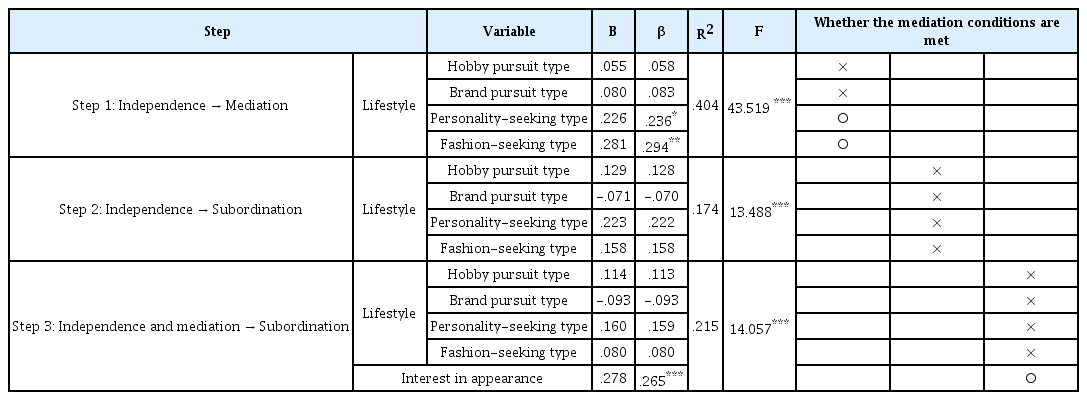
Verification Result of Mediating Effect of Appearance Interest (dependent variable: impulse purchase type)
1단계에서는 라이프스타일의 유행추구형, 개성추구형 순으로 매개변수인 외모관심도에 유의미한 영향력을 미치는 것으로 나타났고, 2단계에서는 라이프스타일은 유의수준 5%에서 충동구매형에 유의미한 영향을 미치지 않는 것으로 나타났다. 3단계에서는 독립변수에 매개변수인 외모관심도를 추가 투입하여 설명력은 21.5%로 유의미하게 상승하였다(ΔF=13.674, p<.001). 충동구매형에 대한 영향력은 외모관심도(β=.265, p<.001)만 유의미한 영향력을 미치는 것으로 나타났고, 이는 외모관심도가 높을수록 화장품구매행동의 충동구매형이 높은 것을 의미하나, 외모관심도의 매개효과는 유의미하지 않는 것을 알 수 있다.
라이프스타일과 화장품구매행동의 브랜드선호형과의 관계에서 외모관심도의 매개효과를 살펴본 결과는 <Table 10>, <Table 11>과 같다.
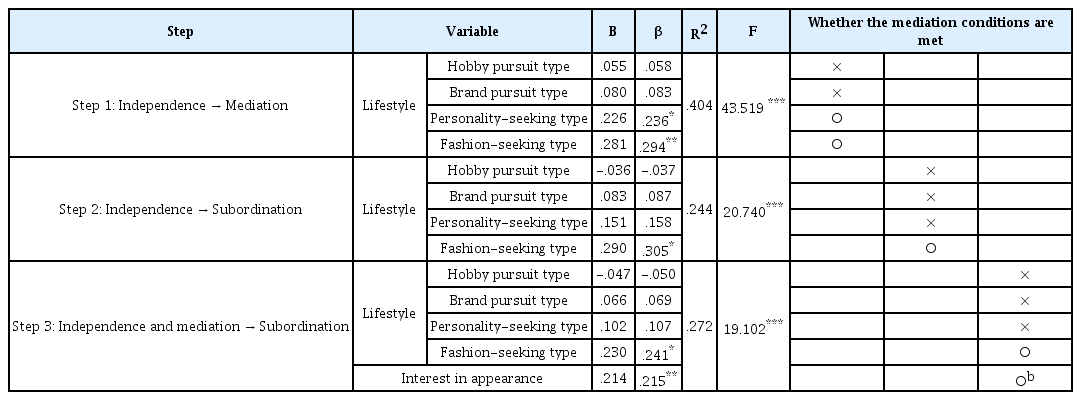
Verification Result of Mediating Effect of Appearance Interest (dependent variable: brand preference type)
1단계에서는 라이프스타일의 유행추구형, 개성추구형 순으로 매개변수인 외모관심도에 유의미한 영향력을 미치는 것으로 나타났고, 2단계에서는 라이프스타일의 유행추구형(β=.305, p<.05)만 화장품구매행동의 브랜드선호형에 유의미한 영향력을 미치는 것으로 나타났다. 3단계에서는 독립변수에 매개변수인 외모관심도를 추가 투입하여 설명력은 27.2%로 유의미하게 상승하였다(ΔF=9.729, p<.01). 브랜드선호형에 대한 영향력은 라이프스타일의 유행추구형(β=.241, p<.05), 외모관심도(β=.215, p<.01) 순으로 유의미한 영향력을 미치는 것으로 나타났고, 이는 라이프스타일의 유행추구형과 외모관심도가 높을수록 화장품구매행동의 브랜드선호형이 높은 것을 의미한다. 따라서, 1단계와 2단계에서 유의미한 유행추구형은 3단계에서 여전히 화장품구매행동의 브랜드선호형에 유의미한 영향을 미치는 것으로 나타나, 외모관심도는 유행추구형과 화장품구매행동의 브랜드선호형과의 관계를 부분매개 하는 것을 알 수 있다. 소벨테스트(Sobel test) 결과 유행추구형과 화장품구매행동의 브랜드선호형과의 관계에서 외모관심도의 매개효과는 유의미하였다(Z=2.024, p<.05).
V. 결 론
본 연구는 중국 20대 여성을 대상으로 인구통계학적 특성을 알아보고 라이프스타일, 외모관심도, 화장품구매행동을 파악하고, 라이프스타일이 화장품구매행동에 미치는 영향에서 외모관심도의 매개효과를 밝히고자 시도되었다. 이를 위해 본 연구는 중국 20대 여성을 조사대상자로 선정하여 조사를 실시하 였다. 설문조사를 2023년 8월 1일부터 8월 31일까지 회수된 설문지 중 응답에서 불완전하거나 성실하지 않은 15부를 제외하고 총 262부를 최종 분석 자료로 사용하였다. 자료분석은 SPSSWIN 21.0 프로그램을 이용하여 빈도분석, 요인분석, 신뢰도검증, 기술통계분석, 상관분석, 회귀분석, sobel 테스트를 사용하였으며 다음과 같은 분석 결과를 제기하였다.
첫째, 조사대상자의 일반적 특성으로 현 거주지는 대도시(베이징, 톈진), 최종학력은 4년제대학(재학)졸업, 결혼상태는 미혼, 직업은 직장인, 월 소득은 50-100만원 미만, 월 평균 화장품 구매 비용은 20-30만원 미만인 경우가 가장 높게 나타났다.
둘째, 라이프스타일, 외모관심도, 화장품 구매행동의 각 하위요인들과의 상관관계는 모두 정(+)의 상관성을 보여, 라이프스타일이 높을수록 외모관심도가 적극적이며 화장품 구매행동이 높은 것으로 나타났다.
셋째, 라이프스타일이 외모관심도에 미치는 영향에서는 라이프스타일의 하위요인 유행추구형과 개성추구형이 높을수록 외모관심도가 높은 것으로 나타났다. 유행추구형의 라이프스타일을 채택하는 사람들은 주변 환경과 사회적 트렌드에 민감하게 반응하는 경향이 있으며 다른 사람들과 조화롭게 어울리려고 하며, 유행에 민감하게 반응한다. 화장품 브랜드는 종종 유행과 관련된 제품을 출시하며, 이러한 유행을 따르는 소비자는 브랜드 선호도를 높일 가능성이 높다.
넷째, 라이프스타일이 화장품구매행동에 미치는 영향에서는 라이프스타일의 하위요인인 유행추구형이 높을수록 화장품구매행동의 자기주도형이 높은 것으로 나타났며, 라이프스타일의 유행추구형이 높을수록 화장품구매행동의 브랜드선호형이 높은 것으로 나타났다. 유행추구형 라이프스타일을 채택하는 소비자들은 종종 새로운 제품과 트렌드를 적극적으로 시도하며, 이를 통해 불만족을 해소하고 새로운 경험을 찾으려는 경향이 있다. 이러한 불만족 해소가 자기주도형 화장품구매행동을 높이고, 브랜드선호도를 형성한다.
다섯째, 라이프스타일과 화장품구매행동과의 관계에서 외모관심도의 매개효과를 검증한 결과, 유행추구형과 화장품구매행동의 자기주도형과의 관계에서 외모관심도의 매개효과는 유의미한 것으로 나타났며, 유행추구형과 화장품구매행동의 브랜드선호형과의 관계에서 외모관심도의 매개효과는 유의미한 것으로 나타났다.
라이프스타일과 화장품구매행동과의 관계에서 외모관심도의 매개효과 검증의 단계별 결과는 다음과 같다. 1단계와 2단계에서 유의미한 유행추구형은 3단계에서 더 이상 화장품구매행동의 자기주도형에 유의미한 영향을 미치지 않는 것으로 나타나, 외모관심도는 유행추구형과 화장품구매행동의 자기주도형과의 관계를 완전매개 하는 것을 알 수 있고 외모관심도는 유행추구형과 화장품구매행동의 브랜드선호형과의 관계를 부분매개 하는 것을 알 수 있다.
이로써 외모관심도는 유행추구형과 화장품구매행동의 자기주도형과의 관계를 완전히 매개하는 것으로 판단된다. 즉, 외모관심도가 유행추구형 라이프스타일과 화장품구매행동의 자기주도형의 간의 중요한 매개효과를 나타났다.
연구 결과는 중국의 20대 여성들이 화장품에 대한 관심을 높게 가지고 있음을 보여준다. 이는 화장품 산업에 대한 기업들의 마케팅 및 제품 개발에 영향을 미칠 수 있으며, 이 산업의 성장과 발전에 기여할 수 있다.
Yoo(2008), Park(2010), Kim(2012), Cha(2013) 선행논문들과 유사한 형태의 라이프스타일의 유형을 지니고 있었으며, 다만 조사대상자들의 연령대가 낮은 20대와 30대를 여성이기 때문에 경제적 상황이 결과의 중요한 변수로 작용하였다. 경제력이 높지 않는 20-30대의 유행을 따르고 여가를 즐기지만 색조화장품 구매 시충동구매성향보다는 계획적이고 실속구매의 소비성향을 지니고 있었고 본 연구의 결과와 유사함을 보였다.
본 연구는 중국 화베이 지역에서 20대 여성을 독립된 하나의 시장으로 보고, 그들의 라이프스타일 유형에 따른 화장품구매행동 및 외모관심도를 분석하여 집단의 특성을 고려한 올바른 소비문화를 유도하고, 이를 위한 소비자 교육 차원의 기초자료 일환으로 활용하고자 하였고 연구 결과를 활용하여 라이프스타일을 기반으로 화장품 산업 서비스와 마케팅 전략을 개발하고 구체화하는데 필요한 기초 자료로 활용할 수 있을 것으로 기대한다.
